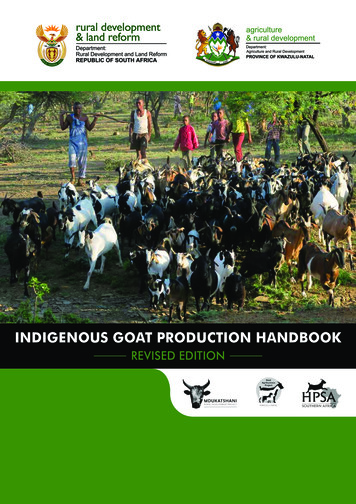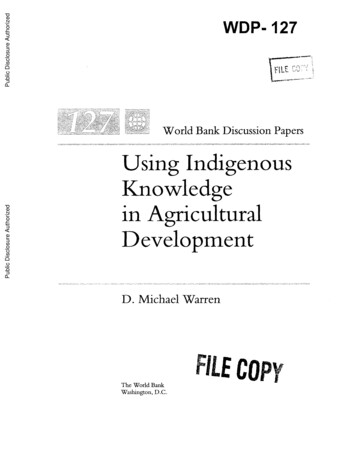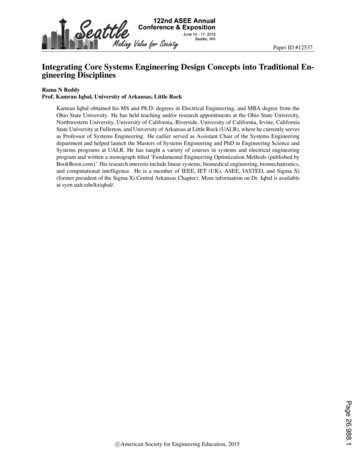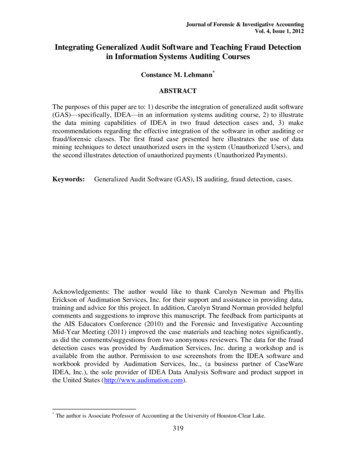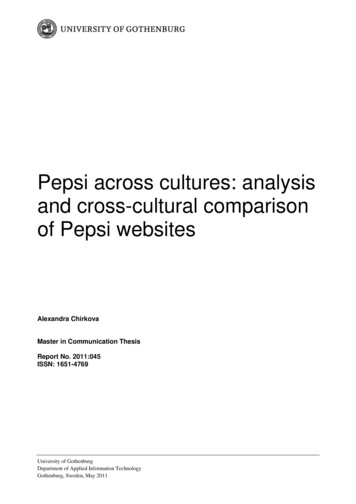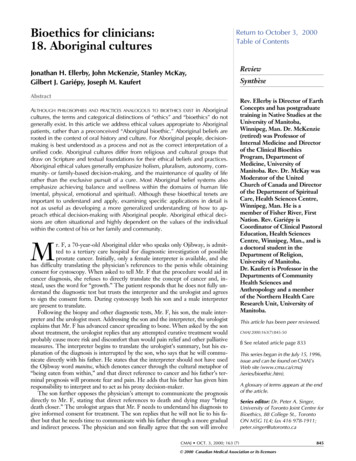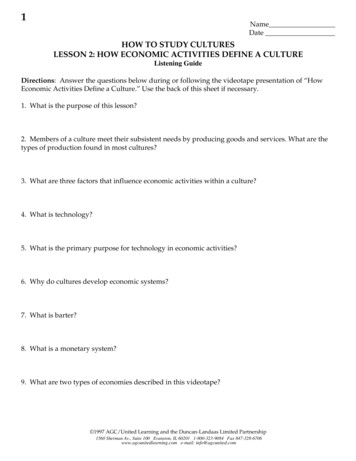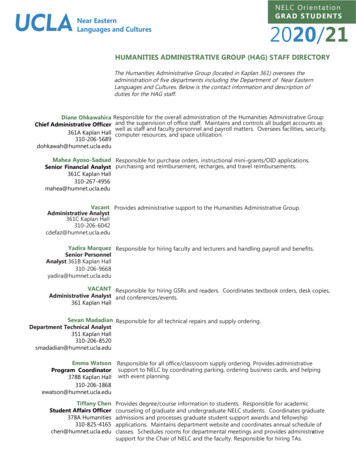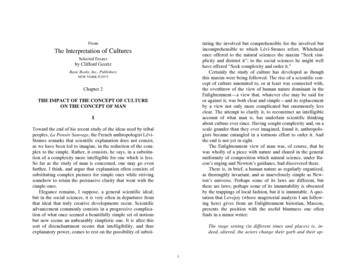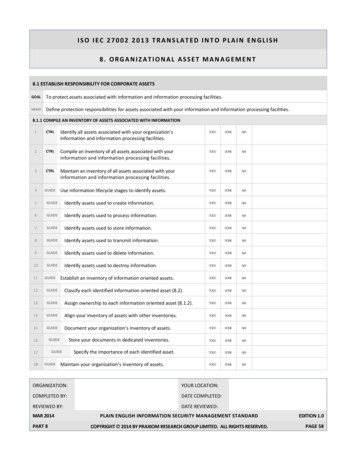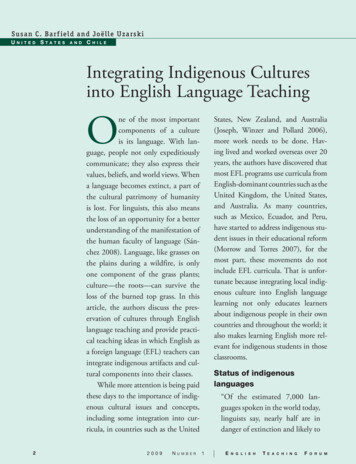
Transcription
Sus a n C . Bar f ie l d a nd Joë lle Uza rs ki —Integrating Indigenous Culturesinto English Language Teaching;One of the most importantcomponents of a cultureis its language. With language, people not only expeditiouslycommunicate; they also express theirvalues, beliefs, and world views. Whena language becomes extinct, a part ofthe cultural patrimony of humanityis lost. For linguists, this also meansthe loss of an opportunity for a betterunderstanding of the manifestation ofthe human faculty of language (Sánchez 2008). Language, like grasses onthe plains during a wildfire, is onlyone component of the grass plants;culture—the roots—can survive theloss of the burned top grass. In thisarticle, the authors discuss the preservation of cultures through Englishlanguage teaching and provide practical teaching ideas in which English asa foreign language (EFL) teachers canintegrate indigenous artifacts and cultural components into their classes.–While more attention is being paidthese days to the importance of indigenous cultural issues and concepts,including some integration into curricula, in countries such as the United22009Nu m b e rStates, New Zealand, and Australia(Joseph, Winzer and Pollard 2006),more work needs to be done. Having lived and worked overseas over 20years, the authors have discovered thatmost EFL programs use curricula fromEnglish-dominant countries such as theUnited Kingdom, the United States,and Australia. As many countries,such as Mexico, Ecuador, and Peru,have started to address indigenous student issues in their educational reform(Morrow and Torres 2007), for themost part, these movements do notinclude EFL curricula. That is unfortunate because integrating local indigenous culture into English languagelearning not only educates learnersabout indigenous people in their owncountries and throughout the world; italso makes learning English more relevant for indigenous students in thoseclassrooms.–Status of indigenouslanguages–“Of the estimated 7,000 languages spoken in the world today,linguists say, nearly half are indanger of extinction and likely to1 En g l i s hTE a c h i n gFo r u m
disappear in this century. In fact, onefalls out of use about every two weeks.”(Wilford 2007, 1).–When a language is lost, a part of culture islost as well. An Economist article (May 3, 2008)on cave paintings in Africa reminded readersthat little is known today about pre-colonial African cultures; some of them becameextinct, along with their languages and beliefs,even before they were named. In the Americas,it is believed that when the Europeans arrived,approximately 1500 languages and dialectswere spoken. Today, approximately 750 havesurvived, and some of them are at risk ofextinction (Sánchez 2008).–In Latin America today, Colombia isamong the most diverse linguistically. Sixtyfive languages belonging to 18 different families are spoken. In Peru, 66 languages belonging to 12 families are spoken. In Mexico,more than 50 languages belonging to tenfamilies have survived and are spoken today.In Chile, 11 indigenous languages are knownto have been spoken, but only three remaintoday. Thirty-six languages are spoken inBolivia, 31 in Venezuela, and 150 or more inBrazil (Sánchez 2008). Of the 65 indigenouslanguages spoken in Colombia, 38 have beenstudied at the Colombian Center for Aboriginal Language Studies at the University of theAndes.–Several of the traditional national universities of Latin America—including San Marcosin Peru, San Andrés in Bolivia, the Universityof Buenos Aires in Argentina, and the National Autonomous University of Mexico, amongothers—have Indigenous Language departments or sections devoted to this topic intheir linguistics or anthropology departments.In Europe, the study of American indigenouslanguages and cultures is being studied at theLatin America Institute at the Free Universityof Berlin and the Department of IndigenousLanguages and Cultures at the University ofLeyden in Holland (Sánchez 2008).–Since the “Hawaiian Renaissance” of the1970s, Hawaiian has begun to regain itsstatus as a living language. The Universityof Hawai‘i at Mānoa recently established theSchool of Hawaiian Knowledge at whichfaculty, students, and alumni, in collaborationwith native speakers of Hawaiian, are workingto revitalize Hawaiian language, culture, andEn g l i s hTEa c h i n gFo r u m literature (http://manoa.hawaii.edu/hshk). Allof this is good news for English languageteachers and students as it means that a wealthof indigenous cultural artifacts and culturalcomponents are available for use in theirclasses, even though language may be at riskof extinction.–As a general overview, an English learning unit that integrates indigenous culturalcomponents—such as dress, food, authenticartifacts, music, dance, and film—will likelyinclude opportunities for participants to sharetheir experiences, in terms of culture and content, and to participate in cooperative learning tasks. Specific cultures can be explored,and several models of bilingual or trilingual(i.e., Spanish, English, and an indigenouslanguage) educational activities can ultimatelyhelp students to improve their proficiency inEnglish.–Practical applications—How do EFL teachers integrate indigenous culture into their teaching? Ideas forspecific lessons appear below. Each lessonhas a component for basic English, advancedEnglish, and discussion questions or activitiesthat address cultural sustainability. Culturalsustainability, the ability to keep a specific culture “alive” when that culture is in danger ofextinction due to assimilation into dominantcultures, is important to teachers, especiallythose who teach indigenous students or teachin countries with indigenous populations.The questions provided are for both indigenous and non-indigenous students; just asking these questions indicates to all studentsthe importance of learning about and preserving cultures throughout the world.–Maori tattoos (New Zealand)–The art of Maori tattooing, or Ta Moko,probably came from Eastern Polynesia. Thereis a myth about how this tattooing began:–There once was a young man, Mataora(“Face of Vitality”) who was in love witha princess, Niwareka, from the underworld. When Mataora beat her, Niwareka ran away, returning to her father’sland of Uetonga. Mataora was heartbroken and set out to find Niwareka.Mataora had many trials and adventureson his way to Uetonga so that when heNumber120093
are adopted], have them choose a culture ofinterest.) Students may choose two cultures,such as one from their mother and anotherfrom their father.–arrived, his face paint was in disarrayand Niwareka’s family made fun of hisappearance. Feeling guilty and humble,Mataora begged Niwareka for forgiveness, and she accepted his plea. Niwareka’s father then taught Mataora the artof tattooing, or Ta Moko, and he andNiwareka returned to the human world,bringing with them this most valuablecultural art form. (Whitmore 2008)–Step 2: Students draw a visual representation of the culture or cultures they chose.Encourage students to think about: What distinguishes the chosen culture from other cultures? What might be a visual representationof that culture? For example, in the Maoriculture, there might be a picture of a whale.Drawings can be abstract, or they can includecertain patterns that represent specific clans intheir community in New Zealand.–Maori tattoos, mostly on the face, indicated ancestry (the father’s side was usuallyon the left, the mother’s on the right) andsocial position (those without rank wouldnot have a design). Examples of Maoritattoos can be found at: http://images.google.com/images?um 1&hl en&q site:travel.nationalgeographic.com maori tattoos.–More information on Maori tattooingcan be found at http://history-nz.org/maori3.html.–Step 3 (optional): Students “paint” their faceswith their designs; be sure and use washableink.–Step 4: Students present their designs to theclass. In preparing their presentations, students will want to consider:– Why did they choose their particulardesigns?– What do the designs represent in thechosen culture?– Why are the designs important tothem?–Basic English: This is a good lesson to introduce the basic vocabulary and definition ofculture.–Step 1: Each student finds his or her own definition of culture. Definitions of culture can befound in dictionaries, on the Internet, or byasking parents, guardians, other teachers orschool staff, and friends outside the classroom.Students write down the definitions.–Cultural sustainability: As a follow-up, havestudents discuss these questions: – How is a person’s social standing determined and shown in a local indigenousculture?– How important is ancestry is this culture?–Step 2: Each student reads his or her definition to the class, and then expresses it in hisor her own words. Does he or she agree or disagree with the definition? Why or why not? –Step 3: A Word Wall is then made to displaykey vocabulary words such as: traditions,language, mores, customs, values, beliefs, andauthentic artifacts. Teachers can place a roll ofpaper on a classroom wall and have studentswrite their definitions of these words as theyare presented or discussed. As new wordscome up in discussions, they are added to theWord Wall.–Bantu storytelling (Mozambique)–Obviously, the Internet is an abundantsource of information on indigenous cultures,but indigenous students in EFL classes canalso be excellent resources. They may notknow that. Teachers can help students appreciate their cultural wealth by encouraging themto share the stories, rituals, and traditionsthat they can gather from their grandparents,older neighbors, religious or spiritual leaders, or community centers—as long as thosestudents feel comfortable sharing with theirclassmates. It must be noted that there is nogeneric indigenous person. The backgroundsof students are varied, and no individual student can be expected to represent groups ofone ethnicity or another.Advanced English: Students will research theirown ancestry and draw, on paper, tattoos thatwould represent that culture or cultures. Theywill then describe the cultural significance ofthe tattoos to their classmates.–Step 1: Have students find one or more cultures of their ancestors. (If they do not knowabout their biological family [for example,42009Number1 En g l i s hTEa c h i n gFo r u m
Carla Maciel, PhD, uses Bantu oral narratives in the training of EFL teachers inMozambique. In her research, she presentsways to help students of English who arenative speakers of Bantu languages explorehow storytellers strategically use language toconvey cultural values. She advises EFL teacher trainers to help pre-service teachers developtheir sense of self-esteem and build pride intheir cultural heritage by gathering oral narratives in their native language, translating theminto English, and investigating and determining the deep cultural values encoded in thenarratives such as virginity prior to marriage,arranged marriages, the concept of the dowry,motherhood, women’s close connection to theearth/land, roles that men and women assumein the traditional society, obligatory familytasks such as cooking, protecting individualmembers, and raising and educating children(Maciel 2007).–The story “Muatakhaliaka” was collectedin Nampula, Mozambique, the area where theMakhuwa ethnic cultural group reside. It isparaphrased below.–Basic English: Students hear a native storyand learn vocabulary that they can recycle totell or write a story of their own.–When colonists ruled Mozambique,a young man named Muatakhaliakaowed five taxes. One day, he left hisvillage with a few of his friends andwent to a town where each of themfound work. Muatakahaliaka’s job wasas a cook.–Muatakhaliaka was not able to visithis wife on the weekends, but his friendsregularly went back to the village. Theysometimes would see Muatakhaliaka’swife, and when they would return to thetown, they would tell Muatakhaliakathat his wife had no clothes; she hadnothing to wear. Muatakhaliaka wouldexplain that he couldn’t do anythingabout it. He was busy working. Muatakhaliaka’s friends did not approve ofhis behavior.–After six months, Muatakhaliakaand his friends finished their jobs andreturned to their village. When theywent to an administrative office toreceive their salaries, Muatakhaliaka’s friends received the money theydeserved, but Muatakhaliaka receivedalmost nothing. The manager told himthat he had worked for free.–En g l i s hTEa c h i n gFo r u mThe last line of the story is: “Muatakhaliaka is a name that should not be given to anybody” (Maciel 2007, 144). –Many cultural components are at playin this story, and teachers may need to helpstudents understand why Muatakhaliaka waspunished. In Makhuwa culture, the systemsof kinship and marriage have great relevance.Makhuwa society is matrilineal, and Muatakhaliaka normally would have lived with hiswife in the home or at least on the land ofhis wife’s family and worked in the fields ofhis (grand)mother-in-law and help producefood that would benefit his wife’s family. Atthe time of colonial rule, Makhuwan menwere expected, as primary money-makers, toprovide clothing for their wives.–Muatakhaliaka disregarded the rules ofhis local community. He did not fulfill hisobligations to his wife’s kin or perform in ahusband’s role as agricultural producer, and hewas so obsessed with his work that he failed tovisit his wife on weekends. Therefore, he waspunished and did not receive the money heneeded to pay his taxes.–Step 1: Invite a native storyteller to visit yourclass and tell a short cultural story (first inEnglish and then in his or her native language,if possible). Have the storyteller tell you thestory before class so you can prepare a prelistening activity to teach students some ofthe key vocabulary. For example, you couldwrite the vocabulary words and definitionson cards, put the students in groups of fouror five, give each student a card, and
Maori tattoos (New Zealand)– The art of Maori tattooing, or Ta Moko, probably came from Eastern Polynesia. There is a myth about how this tattooing began:– There once was a young man, Mataora (“Face of Vitality”) who was in love with a princess, Niwareka, from the under-world. When Mataora beat her, Niware-ka ran away, returning to her father’s land of Uetonga. Mataora was heart .
